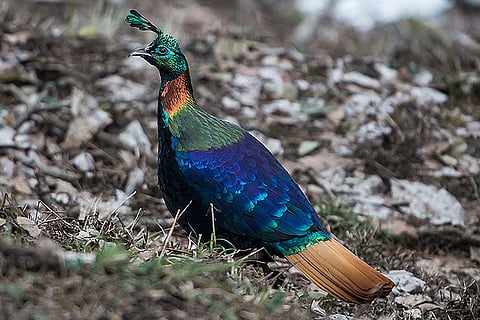
- Destinations
- Experiences
- Stay
- What's new
- Celebrating People
- Responsible Tourism
- CampaignsCampaigns
- SubscribeSubscribe
- Buy Now

Great Himalayan National Park Conservation Area
High alpine peaks, alpine meadows and riverine forests are the main characteristics of this national park located in Himachal Pradesh. The park was inscribed in UNESCO&rsquos World Heritage List in 2014. According to the UNESCO&rsquos citation, the park is &ldquois located within the globally significant Western Himalayan Temperate Forests ecoregion,&rdquo and home to many plants and animals endemic to the region. The park is located in the Kullu district and has to be explored on foot there are both easy and difficult trek routes. The longer treks require camping in the national park. You have to obtain prior permission and pay entry fees and camera charges while visiting the national park.
Kaziranga National Park
This well-known park from Assam was inscribed in UNESCO&rsquos list in 1985. Located on the southern bank of the Brahmaputra River at the foot of the Mikir Hills, the park is home to the Indian one-horned rhinoceros and other animals such as tigers, elephants, panthers, gaur, water buffalo, swamp deer, hog deer, many species of birds, etc. The park is divided into five ranges with their own entry points. You can go on elephant and jeep safaris. Assam is connected with the rest of the country through the airport in Guwahati the nearest airport for the park is Jorhat. Best time to visit November to April.
Keoladeo National Park
Inscribed in UNESCO&rsquos list in 1985, this famous park in Rajasthan &ldquois an important wintering ground of Palaearctic migratory waterfowl&rdquo and is renowned for its large congregation of non-migratory resident breeding birds. Unfortunately, the park has lost its flagship migrant, the Siberian Crane. Earlier, this was the duck shooting preserve of the Bharatpur royals. The sanctuary is located about 60km away from Agra. It is also connected to Sawai Madhopur and Kota via Bharatpur, a town about 2km away from the sanctuary. Winter is the best time to visit the national park when migratory birds arrive.
Manas Wildlife Sanctuary
Located in Assam, along the India-Bhutan border at the foothills of the Eastern Himalayas, the park was included in the UNESCO list in 1985. It is also one of the noted tiger reserves of India. According to the UNESCO&rsquos citations, Manas is recognized not only for its rich biodiversity but also for its spectacular scenery and natural landscape. The wild buffalo population of Manas is probably the only pure strain of this species still found in India. The nearest airport is in Guwahati and the nearest railhead is Barpeta Road. Best time to visit November to April.
Nanda Devi and Valley of Flowers National Park
Located in Uttarakhand, the national park was inscribed on UNESCO&rsquos list in 1988. It is also part of the Nanda Devi Biosphere Reserve. According to UNESCO&rsquos citation, the park &ldquois renowned for its remote mountain wilderness&hellip and is complemented by the Valley of Flowers, an outstandingly beautiful high-altitude Himalayan valley&rdquo whose meadows of alpine flowers and ease of access &ldquohas been acknowledged by renowned explorers, mountaineers and botanists in literature for over a century and in Hindu mythology for much longer&rdquo. The nearest airport is Jolly Grant in Dehra Dun. For Valley of Flowers, you have to travel up to Govind Ghat by road and then trek to the valley via Ghangaria. A visit to the valley can be combined with a visit to Hemkund Sahib, a pilgrimage centre revered by Sikhs and Hindus.
Sunderban National Park
Shared by India and Bangladesh, the park was incorporated in the UNESCO list in 1987. The Indian part of the forest is located in West Bengal. The Sundarban contains the world's largest mangrove forests and is one of the most biologically productive of all natural ecosystems. It is also the only mangrove forest where tigers are found. The Sunderban is a vast network of channels and estuary and hence boats are the popular mode of transport. The national park can be approached from various points to the south of Kolkata. December to March is the best time to visit.
The Western Ghats
Inscribed in the UNESCO Heritage List in 2012, the Western Ghats consist of a chain of mountains running parallel to India&rsquos western coast it starts near the border of Gujarat and Maharashtra, south of the Tapti river, and runs through Maharashtra, Goa, Karnataka, Kerala and Tamil Nadu to end at Kanyakumari, at the southern tip of India. It is not only older than the Himalaya mountain but also represents &lsquogeomorphic features of immense importance with unique biophysical and ecological processes&rsquo. The biodiversity is so vast that the Western Ghats chain is now said to be one of the world&rsquos eight &lsquohottest hotspots&rsquo. The UNESCO tag covers nearly 39 properties, including national parks, wildlife sanctuaries and reserve forests - 20 in Kerala, 10 in Karnataka, 5 in Tamil Nadu and 4 in Maharashtra.
